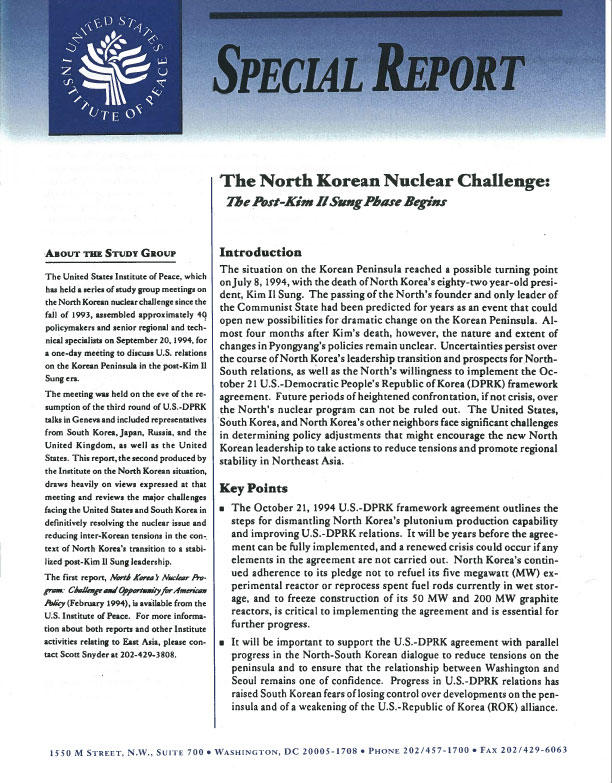The situation on the Korean Peninsula reached a possible turning point on July 8, 1994, with the death of North Korea's eighty-two year-old president, Kim Il Sung. The passing of the North's founder and only leader of the Communist State had been predicted for years as an event that could open new possibilities for dramatic change on the Korean Peninsula. The United States, South Korea, and North Korea's other neighbors face significant challenges in determining policy adjustments that might encourage the new North Korean leadership to take actions to reduce tensions and promote regional stability in Northeast Asia.

The situation on the Korean Peninsula reached a possible turning point on July 8, 1994, with the death of North Korea's eighty-two year-old president, Kim Il Sung. The passing of the North's founder and only leader of the Communist State had been predicted for years as an event that could open new possibilities for dramatic change on the Korean Peninsula. Almost four months after Kim's death, however, the nature and extent of changes in Pyongyang's policies remain unclear. Uncertainties persist over the course of North Korea's leadership transition and prospects for North-South relations, as well as the North's willingness to implement the October 21 U.S.-Democratic People's Republic of Korea (DPRK) framework agreement. Future periods of heightened confrontation, if not crisis, over the North's nuclear program can not be ruled out. The United States, South Korea, and North Korea's other neighbors face significant challenges in determining policy adjustments that might encourage the new North Korean leadership to take actions to reduce tensions and promote regional stability in Northeast Asia.
- The October 21, 1994 U.S.-DPRK framework agreement outlines the steps for dismantling North Korea's plutonium production capability and improving U.S.-DPRK relations. It will be years before the agreement can be fully implemented, and a renewed crisis could occur if any elements in the agreement are not carried out. North Korea's continued adherence to its pledge not to refuel its five megawatt (MW) experimental reactor or reprocess spent fuel rods currently in wet storage, and to freeze construction of its 50 MW and 200 MW graphite reactors, is critical to implementing the agreement and is essential for further progress.
- It will be important to support the U.S.-DPRK agreement with parallel progress in the North-South Korean dialogue to reduce tensions on the peninsula and to ensure that the relationship between Washington and Seoul remains one of confidence. Progress in U.S.-DPRK relations has raised South Korean fears of losing control over developments on the peninsula and of a weakening of the U.S.-Republic of Korea (ROK) alliance.
- Washington must be attentive to South Korean concerns and reassure Seoul of the undiminished commitment of the U.S. to South Korea. This requires not only exceptional governmental measures to coordinate policy, but also efforts to build public support for common policy as the U.S. and South Korea both parties deal with North Korea on nuclear and other issues.
- South Korea should be actively involved in diplomacy with North Korea, relying on the South's economic, political, and military strengths and searching for appropriate opportunities to reactivate the North-South dialogue. The South will have a major role in supplying North Korea with light-water reactors. At the same time, the United States should take steps to ensure that the degree of progress toward normalization of U.S.-DPRK relations does not outpace the development of North-South relations.
- There is still little reliable information about how the North Korean political succession is proceeding. Kim Il Sung's death may not have precipitated a period of policy paralysis in North Korea, but it has created considerable uncertainty for outsiders. Doubts remain among foreign observers about whether the elder Kim's son and designated successor, Kim Jong Il, will ultimately consolidate his power. These questions persist despite the younger Kim's stepped-up public appearances following the ceremony marking 100 days of mourning for his father and reports that the elder Kim, before his death, approved a policy of improving U.S.-DPRK relations at the cost of relinquishing the North's nuclear program. Even if Kim Jong Il is finally named as North Korea's state and party leader, the transition has made it more difficult to achieve progress in the North-South dialogue.
- To encourage North Korea's commitment to implement the October 21 agreement, the United States must maintain close cooperation with South Korea, Japan, China, and others so that the post-Kim Il Sung leadership does not doubt the international consensus in support of the agreement's implementation. Maintenance of an international coalition on these issues is critical to convincing Pyongyang that it cannot succeed in diplomatic maneuvers designed to split off elements of the coalition or to stall in implementing the agreement.